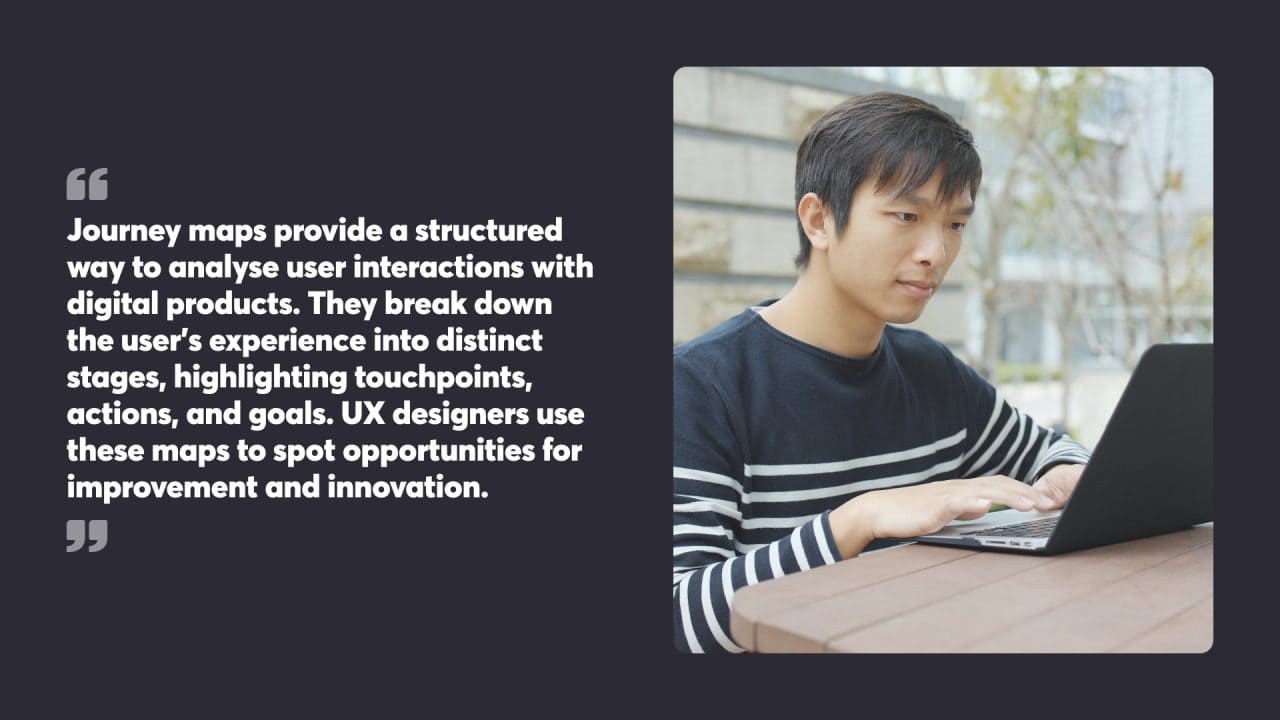
UX design shapes digital experiences, guiding users through products and services with intuition and purpose. It’s about crafting a journey that aligns with user expectations and business goals. Effective UX design creates a seamless path from awareness to retention, addressing user needs at each stage by utilising a user journey map.
User journey mapping is a key tool in this process. It visualises the steps a user takes when interacting with a website, highlighting their thoughts, feelings, and pain points. This approach allows designers to identify opportunities for improvement and create more engaging experiences.
By focusing on user-centred design principles, UX professionals can create products that resonate with their target audience. This involves understanding user motivations, conducting research, and iterating based on feedback. The result is a product that functions well and connects with users on an emotional level.
Key Takeaways
- User journey mapping is a powerful tool that visualises the steps users take when interacting with a product, highlighting their thoughts, feelings, and pain points at each stage.
- Effective UX design balances user needs with business objectives by conducting thorough user research, creating personas, and iterating based on feedback.
- Crafting compelling user journeys requires a strategic combination of intuitive interface design, engaging visual elements, and continuous learning.

Table of Contents
Understanding the User Journey
User journey mapping is a crucial tool in UX design, offering insights into user behaviours and pain points. It helps create intuitive experiences that meet user needs effectively.
What is a User Journey in UX?
A user journey in UX refers to the sequence of interactions a user has with a product, service, or system to achieve a specific goal. It encompasses the user’s thoughts, feelings, and actions as they navigate through various touchpoints and stages of the experience. Understanding the user journey is crucial in UX design as it helps designers identify pain points, opportunities for improvement, and areas where they can create memorable user experiences.
By mapping out the user journey, designers gain valuable insights into how users interact with their products. This visual representation allows them to pinpoint moments of friction and areas where users may feel frustrated or confused. Addressing these pain points can lead to a smoother, more enjoyable experience, ultimately increasing user satisfaction and loyalty.
Moreover, understanding the user journey helps designers create experiences that resonate emotionally with users. By considering the user’s thoughts and feelings at each stage, designers can craft interactions that meet functional needs while creating positive, memorable experiences. This holistic approach ensures that the product both works well and delights users, fostering long-term engagement and retention.
Essentials of User Journey Mapping
User journey maps visually represent a user’s interactions with a product or service. They highlight key touchpoints, channels, and user actions across different stages of engagement. These stages typically include awareness, consideration, decision, purchase, and retention.
Journey maps showcase user thoughts, feelings, and experiences at each stage, often rating them as good, neutral, or bad. This comprehensive view helps designers spot friction points and areas for improvement.
By mapping out the journey, UX designers can craft more user-centric solutions. They gain a clearer picture of user motivations and can better align the product with user expectations.
Roles of User Research and Personas
Conducting user research forms the foundation of effective journey mapping. It involves gathering data on user behaviours, preferences, and pain points through methods like interviews, surveys, and usability tests.
This research helps build user personas – fictional characters representing key user groups. Personas encapsulate user demographics, goals, and challenges, making it easier for designers to empathise with users.
Combining personas with journey maps creates a powerful tool for understanding user needs. It allows designers to view the product experience through the user’s eyes, leading to more targeted improvements.
User research and personas also help validate assumptions about user behaviour. This data-driven approach reduces guesswork and leads to more informed design decisions.

Designing for Engagement
Effective user engagement stems from thoughtful interface design and strategic visual elements. These components work together to create experiences that captivate users and encourage them to explore further.
Creating Intuitive Interfaces
Intuitive interfaces form the backbone of engaging user experiences. Designers should focus on simplifying navigation and reducing cognitive load. Clear visual hierarchies guide users through content, while consistent layouts across screens help build familiarity.
Well-placed calls-to-action encourage user interaction without overwhelming them. Predictable button placement and recognisable icons aid in creating a user-friendly environment. Concise, descriptive labels for menu items and buttons further enhance usability.
Responsive design principles ensure seamless experiences across devices. Adapting layouts and functionality to different screen sizes maintains engagement regardless of how users access the interface.
Incorporating Visual Elements
Strategic use of visual elements elevates user engagement. Colour psychology plays a key role in setting the right mood and guiding attention. Carefully chosen colour palettes can highlight important information and create visual harmony.
Typography choices impact readability and brand identity. Legible fonts at appropriate sizes improve comprehension, while unique typefaces can reinforce brand personality. Proper text formatting, including line spacing and contrast, reduces eye strain during extended use.
Imagery and iconography add visual interest and convey information quickly. Custom illustrations or high-quality photographs can make interfaces more appealing and memorable. Animated elements, when used sparingly, can draw attention to key features or provide feedback on user actions.
How Interaction Design Elevates the User Experience
Interaction design plays a vital role in elevating the user experience by crafting intuitive and engaging interactions that cater to user needs. By considering the five dimensions of interaction design – words, visual representations, physical objects or space, time, and behaviour – designers can create harmonious flows that guide users through the experience.
Words are crucial in providing clear instructions and feedback, ensuring users understand what actions to take. Visual representations, such as icons and images, help convey information quickly and effectively. Physical objects or space refers to the tangible elements users interact with, while time encompasses the duration and sequence of interactions. Behaviour focuses on how users respond to and interact with the system.
Effective interaction design enhances user engagement by making interactions feel natural and intuitive. When users can easily navigate and understand a product, they are more likely to stay engaged and explore further. This increased engagement leads to higher satisfaction and a more positive overall experience.
By guiding users through well-designed interactions, designers can create a seamless journey that meets user needs and expectations. This approach improves usability and fosters a deeper connection between the user and the product, ultimately leading to increased user loyalty and retention.

The Art of User Feedback
User feedback drives effective UX design. It offers valuable insights into user satisfaction and pain points, guiding designers towards creating more user-friendly products.
Conducting Usability Testing
Usability testing involves observing users as they interact with a product or prototype. Designers set up controlled environments where participants complete specific tasks while thinking aloud. This method reveals how users navigate interfaces and highlights areas of confusion or frustration.
Effective usability tests require careful planning. Designers must select a diverse group of participants, create realistic scenarios, and ask open-ended questions. During the test, observers take notes on user behaviour, task completion rates, and time spent on each task.
Remote usability testing has gained popularity, allowing designers to reach a broader audience. Tools like screen-sharing software and specialised platforms facilitate these tests, providing valuable data on user interactions across different devices and locations.
Analysing Pain Points and Satisfaction
Analysing pain points and satisfaction is a critical step in the design process. By conducting user research and gathering user feedback, designers can identify areas where users are struggling or experiencing frustration. This information can be used to inform design decisions and create solutions that address these pain points.
User research methods such as interviews, surveys, and usability testing provide valuable insights into user experiences. By observing how users interact with a product and listening to their feedback, designers can uncover specific pain points that hinder the user journey. These insights are crucial for making targeted improvements that enhance usability and satisfaction.
On the other hand, understanding what satisfies users can help designers replicate those experiences and create more positive interactions. By identifying elements that users find enjoyable or valuable, designers can emphasise these aspects in the product, leading to a more engaging and satisfying experience.
Balancing pain points and satisfaction is essential for creating user journeys that are both efficient and enjoyable. By addressing areas of frustration and enhancing elements that users love, designers can craft experiences that meet functional needs and delight users. This approach ultimately leads to increased user satisfaction and loyalty, ensuring that users continue to engage with the product over time.
Analysing Pain Points and Satisfaction
Analysing user feedback involves identifying recurring issues and areas of satisfaction. Designers use various methods to gather this information, including surveys, interviews, and analytics data.
Surveys help collect quantitative data on user satisfaction levels and specific feature preferences. Open-ended questions in surveys can uncover qualitative insights into user experiences and expectations.
User interviews provide in-depth perspectives on pain points and satisfaction. Skilled interviewers can probe deeper into user motivations and behaviours, uncovering insights that may not be apparent from quantitative data alone.
Analytics tools track user behaviour on websites and apps, revealing patterns in user flow and engagement. Heat maps and session recordings offer visual representations of how users interact with digital products, highlighting areas of high and low engagement.

User-Centric Product Development
User-centred design forms the foundation of successful product development. This approach places users at the core of every decision, from initial concept to final release. By focusing on users’ needs, preferences, and behaviours, designers create products that resonate with their target audience.
The product development process begins with thorough research. Teams gather data on users’ habits, pain points, and goals. This information helps shape the direction of the project and informs key design choices.
Journey mapping is a valuable tool in user-centred design. It visualises the steps a user takes when interacting with a product, highlighting areas for improvement. By analysing these maps, designers can identify pain points and optimise the user experience.
Prototyping and testing play crucial roles in refining the product. Early prototypes allow designers to gather feedback and make iterative improvements. This process helps catch issues before they become costly problems later in development.
User testing provides direct insights into how people interact with the product. Observing users’ actions and listening to their feedback guides designers in making informed decisions. These tests often reveal unexpected issues or opportunities for enhancement.
Collaboration between designers, developers, and stakeholders is essential. Regular communication helps keep the project aligned with user needs throughout the development cycle. This teamwork leads to a more cohesive and user-friendly final product.

Mapping the Digital User Experience
Journey mapping is a powerful tool for visualising and improving the digital user experience. It helps UX designers create more effective and engaging digital products by focusing on user actions and emotions.
Leveraging Journey Maps for Digital Products
Journey maps provide a structured way to analyse user interactions with digital products. They break down the user’s experience into distinct stages, highlighting touchpoints, actions, and goals. UX designers use these maps to spot opportunities for improvement and innovation.
Journey maps typically include key elements like user personas, timelines, and channels. They might show how a customer discovers a mobile app, signs up for an account, and completes a purchase. By mapping out each step, designers can identify pain points and areas where the experience could be smoother or more enjoyable.
These visual representations help teams align on user needs and prioritise design efforts. They’re particularly useful for complex digital products with many features or long-term user relationships.
Designing for User Actions and Emotional States
Understanding both what users do and how they feel is crucial for creating positive digital experiences. Journey maps incorporate emotional states alongside user actions, giving a fuller picture of the experience.
Designers use colour coding, emotive icons, or numeric scales to represent user feelings at different stages. This emotional mapping helps identify moments of frustration or delight, guiding where to focus design improvements.
For example, a journey map might reveal that users feel confused during the onboarding process of a web application. This insight could lead to redesigning the welcome screens or adding more helpful tooltips.
By considering emotional states, UX designers can create digital products that function well and also resonate with users on a deeper level. This approach helps build more engaging and memorable digital experiences.

Strategic UX Design Principles
Effective UX design hinges on key principles that guide the creation of user-centred digital experiences. These principles form the foundation for crafting interfaces that meet user needs and business goals.
The Importance of Continuous Learning
UX designers must stay current with evolving technologies and user expectations. Regular skill updates help professionals adapt to new design tools and methodologies. Attending workshops, reading industry publications, and participating in online courses are valuable ways to expand knowledge.
Designers who embrace lifelong learning can better anticipate user needs and create more intuitive interfaces. They gain insights into emerging trends and can apply fresh perspectives to their work. This ongoing education also helps UX professionals communicate more effectively with developers and stakeholders.
Continuous learning fosters innovation in UX design. It enables designers to experiment with new techniques and push the boundaries of what’s possible in digital interfaces. By staying curious and open to new ideas, UX designers can craft more compelling and efficient user journeys.
Balancing Functionality with Aesthetics
A key aspect of strategic UX design is striking the right balance between functionality and visual appeal. Interfaces must be practical and easy to use while also being visually engaging. This balance helps create a positive user experience that goes beyond mere functionality.
Designers should prioritise usability when making aesthetic choices. Clear typography, intuitive layouts, and consistent colour schemes contribute to both form and function. Visual elements should guide users through tasks without causing confusion or distraction.
Aesthetics play a crucial role in brand perception and user engagement. Attractive interfaces can increase user satisfaction and loyalty. However, designers must avoid sacrificing usability for the sake of visual flair. The goal is to create designs that are both beautiful and highly functional.
User testing is essential for finding the right balance. It helps identify areas where aesthetics might be hindering usability or where functional elements could benefit from visual enhancement. Through iterative design and testing, UX professionals can craft interfaces that delight users while meeting their practical needs.

Engaging with the Target Audience
Effective UX design hinges on understanding and connecting with the target audience. This process involves pinpointing crucial interaction points and crafting experiences that align with user objectives.
Identifying Key Touchpoints and Opportunities
User journey mapping helps identify critical touchpoints where users interact with a product or service. These touchpoints offer chances to enhance the user experience and address pain points. UX designers analyse user behaviour at each stage, from initial awareness to post-purchase interactions.
Surveys, interviews, and analytics data provide insights into user needs and preferences. By examining this information, designers spot gaps in the current experience and uncover opportunities for improvement. They might find ways to streamline the checkout process or simplify navigation.
Prioritising touchpoints based on their impact on user satisfaction and business goals is essential. This focus allows designers to allocate resources effectively and create targeted solutions.
Crafting Experiences to Meet User Goals
User-centric design puts the audience’s needs and goals at the forefront. Designers create personas representing typical users to guide their decisions. These fictional characters embody key traits, motivations, and behaviours of the target audience.
Empathy mapping helps designers step into users’ shoes, considering their thoughts, feelings, and actions. This exercise leads to more intuitive and satisfying user experiences. Designers can then develop features and interfaces that address specific user pain points and desires.
Prototyping and user testing play vital roles in refining the user experience. These methods allow designers to validate their ideas and gather feedback before full implementation. Iterative testing helps fine-tune the design to better meet user expectations and goals.
For a website design that gets you on the journey towards happy customers, contact the team at Chilybin today.




